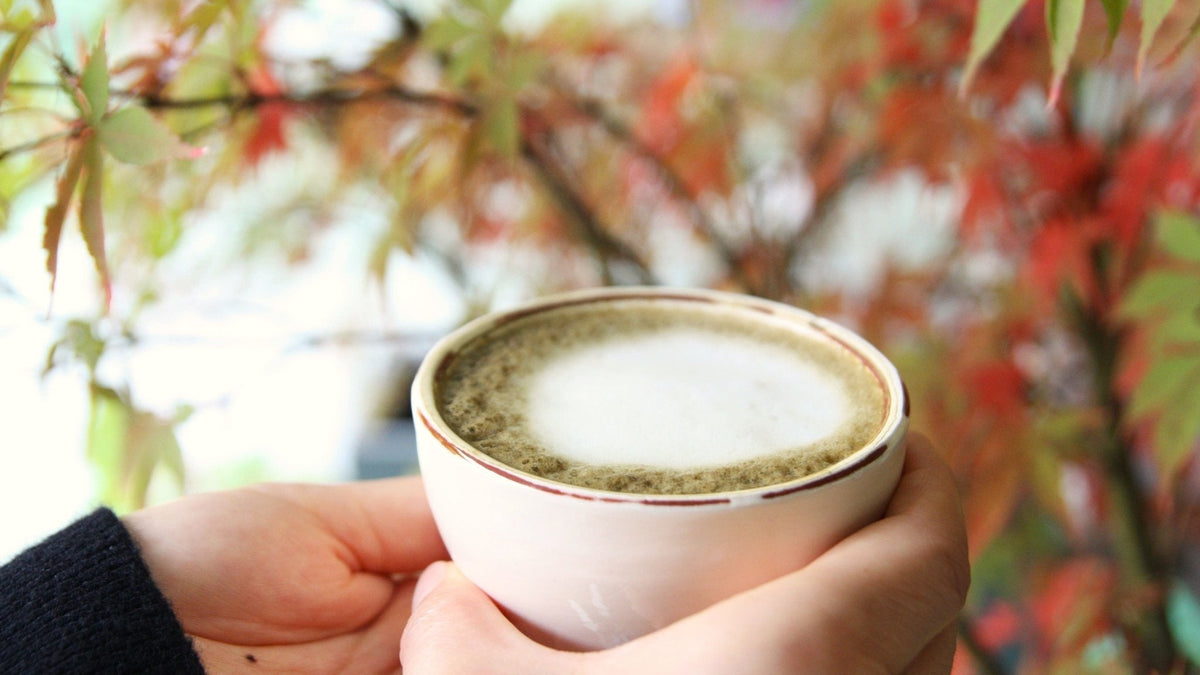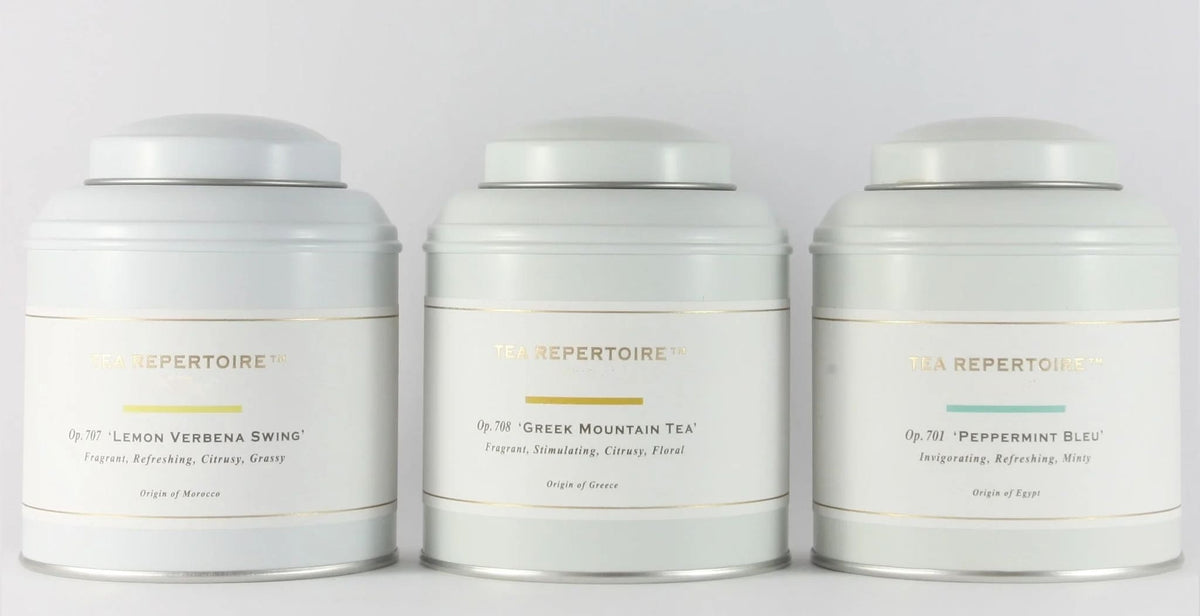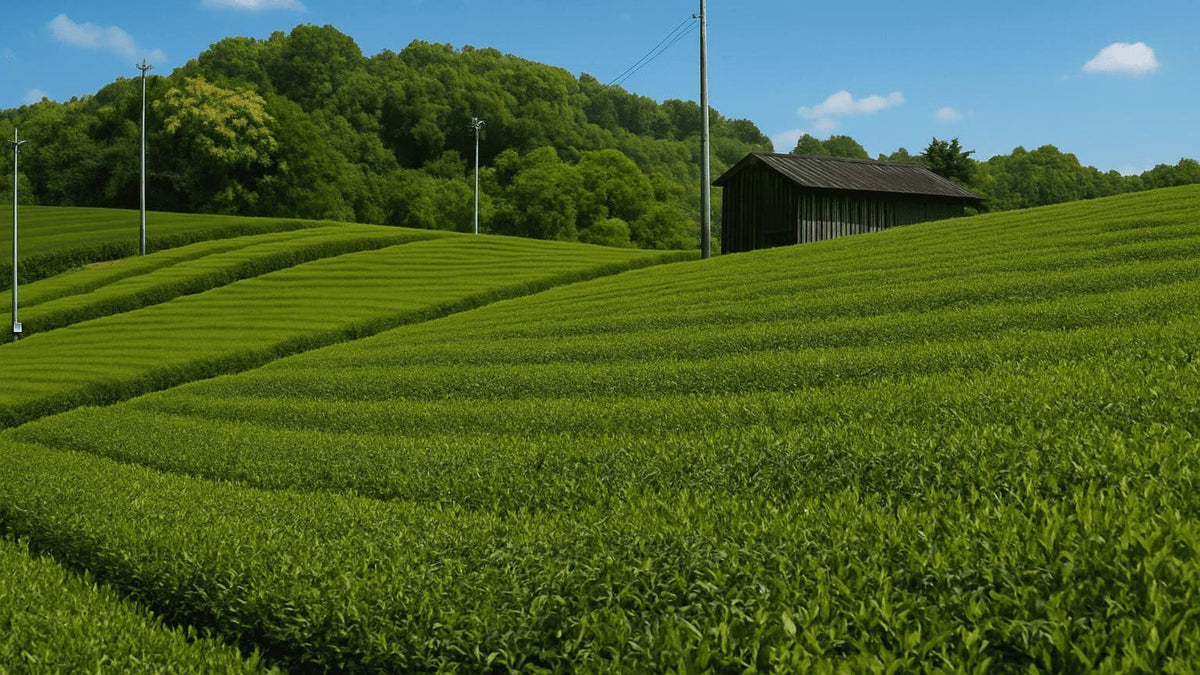The ultimate guide to matcha
Matcha has taken the world by storm. From serene tea ceremonies in Kyoto to green-hued lattes in hip cafés, this finely ground green tea powder has become synonymous with wellness, mindfulness, and taste. But matcha isn’t just trendy — it’s rooted in centuries of tradition, brimming with health benefits, and more versatile than you might expect.
This guide covers everything from matcha’s origins and benefits to how to choose, prepare, and cook with it. Whether you’re a curious beginner or a longtime enthusiast, this is your go-to resource for all things matcha.
What is Matcha?
Matcha is a finely grounded powdered green tea from Japan, made from Camelia Sinensis var. Sinensis tea leaves shade-grown for 3-4 weeks before the harvest. Due to its limited exposure to the sunshine, tea plants undergo a chain of physiological changes in order to survive, which, in turn, results in the changes of the chemical composition of the tea leaves. Produced this way, Matcha tea is extremely rich in L-theanine, an amino acid that increases the sense of well-being and helps relaxation and chlorophyll and catechin, powerful antioxidants known for its potential health benefits such as promoting heart health, cancer prevention, boosting the immune system and helping anti-ageing.
Matcha is a very popular in Japan and its popularity is increasing around the world due to its well-known great health benefits. It can be consumed in a traditional way with only hot water in the form of Usucha and Koicha or consumed with milk, as in popular Café drinks such as Matcha Latte, Matcha Frappuccino and Matcha Affogato.
How It’s Grown:
-
Shaded growth: Plants are shaded 3-4 weeks before harvest to boost chlorophyll and L-theanine.
-
Stone-ground: Leaves are steamed, dried, and ground into an ultra-fine powder.
The Origins of Matcha
Matcha’s story begins in China during the Tang Dynasty, but it found its cultural home in Japan. It became central to the Japanese tea ceremony, championed by Zen monks like Eisai for its meditative qualities. Over centuries, it evolved from religious ritual to daily nourishment and now global superfood.
The Health Benefits of Matcha
Having said that Matcha is rich in antioxidants, called catechins, matcha contains especially a high level of a catechin called EGCG (epigallocatechin gallate), which is believed to have cancer-fighting effects on the body, boost metabolism, prevent heart disease, type 2 diabetes, lower down blood pressure and cholesterol, help weight loss and detox by removing free radicals in our body. Matcha also helps our concentration and focus during work, study, exercise and meditation.
EGCG is also found in other green teas, but matcha contains higher level of EGCG than loose leaf green teas. If you'd like to boost your healthy life style, matcha is definitely one of the superfood nutrients to include in your diet.
Health benefits of Tea - how tea can help you live a healthier life
Does the Matcha contain Caffeine?
Matcha contains more caffeine than green tea, but less than coffee or black tea. If you're quite sensitive to caffeine, it's recommended to drink Matcha in the morning or early afternoon by latest.
What is Caffeine and How Much Caffeine is in your Tea?
How Does Matcha Taste Like?
Matcha offers a complex, multi-layered taste experience unlike any other tea. At its core, high-quality matcha — particularly ceremonial grade — delivers a rich, full-bodied flavor that unfolds across your taste buds in waves. The first impression is typically sweet and umami, a savory depth that’s often described as mouthwatering and satisfying. As you sip, a vegetal and grassy note emerges, reflecting matcha’s shade-grown cultivation and its high chlorophyll content. This greenness feels fresh rather than overpowering. Toward the finish, a slight astringency and bitterness may appear, providing a balancing edge that prevents the sweetness from feeling cloying. This interplay between sweet, savory, grassy, and astringent tones creates a sophisticated, lingering flavor that true matcha lovers crave. Lower-grade matcha tends to be more bitter and less nuanced, while ceremonial matcha highlights the harmonious balance that makes authentic matcha so special.
Different Grades of Matcha
There are so many different matcha brands in the market and the majority of matcha we find are all sold as a premium ceremonial matcha, however, it is unfortunately not always the case that the matcha you buy is a real ceremonial matcha that is sold as a ceremonial grade in Japan.
When you visit well-established matcha farms in Japan, it is common to see they offer 15 - 20 different grades and kinds of matcha in their selection. Usually the top 4 matcha are Koicha ceremonial grade matcha and the rest 10 - 15 are different grades of Usucha ceremonial grade matcha and the rest 5 are different grades/blend of culinary matcha.
What is Koicha and Usucha?
In traditional Japanese tea ceremonies, matcha can be prepared in two distinct styles: Koicha and Usucha. Koicha, meaning "thick tea," uses a larger amount of matcha powder (typically double) mixed with a small amount of hot water to create a dense, syrupy consistency. It is rich, intensely umami, and almost free of bitterness when made with high-grade ceremonial matcha. Koicha is traditionally reserved for formal tea gatherings and requires the highest quality leaves to ensure a smooth, luxurious flavor. In contrast, Usucha, or "thin tea," is the more common preparation, made with less powder and more water to produce a lighter, frothier beverage. Usucha highlights the grassy, slightly sweet, and astringent notes of matcha, offering a refreshing and approachable taste. While both styles celebrate matcha’s layered complexity, the choice between Koicha and Usucha depends on the occasion, the quality of the matcha, and the drinker's personal preference.
When matcha is Koicha or Usucha grade, matcha farmers use more prestigious and premium cultivars (almost always these elite cultivars are much more expensive than other cultivars used to make Sencha, as the production is so limited) which will yield a distictively pronounced umami, nutty and vegetal flavour and creamy texture in matcha. Therefore, these matcha is best when it's consumed with hot water only, as blending with milk will take way all its finesse in flavour and texture.
To better understand the differences between Koicha and Usucha, here’s a quick comparison:
| Feature | Koicha (Thick Tea) | Usucha (Thin Tea) |
|---|---|---|
| Matcha Amount | Double the usual amount (3 - 4g) | Standard amount (1.5 - 2g) |
| Water Amount | 30-35ml (creates a thick consistency) | 60-70ml (creates a light consistency) |
| Texture | Thick, syrupy | Light, frothy |
| Flavor Profile | Rich, smooth, intense umami, very little bitterness | Fresh, slightly grassy, with mild sweetness and astringency |
| Occasion | Formal tea ceremonies | Everyday enjoyment |
| Matcha Grade | Highest quality ceremonial matcha needed | High or standard ceremonial grade |
What is Culinary Matcha?
When matcha is culinary grade, it's meant to be used for making matcha latte, matcha ice cream, pastry, chocolates and desserts. However, there are some striking quality differences among culinary grade matcha and this becomes evident when baking a cake or making a matcha latte - when you use a top quality culinary matcha, it gives a beautiful fluorescent green colour (instead of yellowish green colour - yellowish green colour means the matcha is made from tea plants which are not properly shaded and it's a sign of low quality and this kind of matcha often gives harsh grassy bitterness and unpleasant seaweed flavour). Likewise, if you use a good, decent quality culinary grade matcha for your matcha latte, you won't need to add any sugar or honey in your matcha latte, as the flavour profile is quite similar to the ceremonial Usucha matcha (smooth, nutty and vegetal) and lacking in unpleasant bitterness.
Essential Matcha Tools at a Glance
-
Chawan (Matcha Bowl): Wide and deep, designed for vigorous whisking and a smooth froth.
-
Chasen (Bamboo Whisk): Handcrafted whisk with multiple tines to create a light, airy foam.
-
Chashaku (Bamboo Scoop): Traditional scoop for measuring the perfect amount of matcha powder.
-
Sifter: Fine mesh sieve to break up clumps and ensure a silky, lump-free matcha.
How to Make the Perfect Matcha
I listed different matcha preparation methods below - Usucha, Koicha and Matcha Latte preparation. This preparation methods work perfectly well while using our matcha from Tea Repertoire, as we source only top quality matcha from different award-winning, matcha farms in Japan. Be aware that there are so many different grades of matcha, all sold as a premium ceremonial matcha in the market, however, quality difference is significant and you will have to know how to discern the quality difference when choosing your matcha and adapt and adjust the given preparation method, if your matcha quality is not corresponding to the quality of Tea Repertoire matcha that we offer.
How to Prepare a Ceremonial Matcha with Usucha?
- Sift the Matcha to remove any lumps and enhance its mellow flavour.
- Place 2 Chashaku or 1 teaspoon of Matcha (approx. 2g) into the Chawan bowl.
- Pour 70ml of hot water (70℃) and whisk the Matcha with a bamboo Chasen until it becomes creamy and foamy.
N.B. We offer Usucha grade matcha in our matcha collection - Matcha Bliss, Matcha Mellow Green and Matcha Samidori from two award-winning, historical, matcha tea gardens in Uji, Matcha Aoyama, Matcha Yuki and Matcha Taki fom an award-winning matcha biological tea farm in Kagoshima, Matcha Saemidori and Matcha Okumidori from a certified EU/USDA organic, ecological matcha farm in Kagoshima. Some are blended matcha of 2 -3 different tea cultivars and some are single-cultivar matcha. They are all fantastic quality, real, top ceremonial matcha.
How to Prepare Ceremonial Matcha with Koicha?
- Sift the Matcha to remove any lumps and enhance its mellow flavour.
- Place 4 Chashaku or 2 teaspoon of Matcha (approx. 3 - 4g) into the Chawan bowl.
- Pour 40ml of hot water (70℃) and stir the Matcha with a bamboo Chasen in a circle around the chawan until the mixture becomes a smooth paste.
N.B. We offer Koicha grade matcha in our matcha collection - Matcha Eroica, Matcha Okunoyama, Matcha Claire Lune, Matcha Salut d'Amour, Matcha Manhattan, Matcha Tannhauser, and Matcha Lohengrin are real top ceremonial, Koicha grade matcha. Experience how incredibly smooth, creamy, delicious yet powerful Koicha can taste by trying one of our real top Koicha grade matcha.
How to Prepare a Matcha Latte?
- Place 2 teaspoons of Matcha (approx. 3g) into the Chawan bowl.
- Pour in 10 ml water and stir with a bamboo whisk until lumps disappear.
- Pour 40 ml of hot water (70℃) to blend matcha and hot water with bamboo whisk.
- Warm up and froth 150ml of milk.
- Gently pour the frothed milk over the matcha/water mixture.
- Enjoy your perfectly smooth and delicious matcha latte.
N.B. If needed, you can add sugar or honey. If you're using our Matcha Latte Supreme, Matcha Delight ou Matcha Evergreen Bio you'll notice there's no bitterness and you won't need to add any sweetener to cover any unpleasant bitterness in matcha.
Refresh and Revitalize: The Ultimate Iced Matcha Latte Recipe and Its Health Benefits
Popular Matcha Recipes
-
Matcha smoothie
-
Matcha pancakes
-
Matcha energy balls
-
Matcha ice cream
How to Choose the Best Matcha
-
Origin: Japan, Uji, Kagoshima, Shizuoka — top Japanese regions for Matcha
-
Color: Bright, vibrant green
-
Texture: Fine and silky
-
Smell: Fresh, nutty, grassy, slightly sweet
Storing Matcha the Right Way
-
Store in an airtight, opaque container
-
While sealed, keep in the fridge or a cool, dark place
-
Once open, Use within 2–3 months for peak flavor and nutrition
Conclusion: Why Matcha Matters
Matcha is more than just a health trend — it’s a holistic experience. From its calming rituals to its nutrient-packed punch, incorporating matcha into your daily routine can bring clarity, energy, and joy.
Whether you’re here to explore its cultural richness or harness its health benefits, this guide is your matcha home base.
Leave a comment
Comments will be approved before showing up.
Also in TEA JOURNAL

How to Make the Perfect Hojicha Latte – A Barista’s Guide from Tea Repertoire
Discover how to craft the perfect Hojicha Latte — a smooth, nutty Japanese roasted tea drink that’s as comforting as it is refined. In this barista-approved recipe, Tea Repertoire shares the secrets behind achieving the ideal balance between roasted depth and creamy sweetness using organic Hojicha powder sourced directly from Shizuoka, Japan.

A Guide to Gifting Tea
A Guide to Gifting Tea: The Perfect Tea for Every Taste
Looking for the ideal tea gift? Whether it’s smooth Taiwanese oolongs, fragrant Jasmine Phoenix Pearls, or caffeine-free herbal teas, Tea Repertoire offers thoughtful recommendations to delight any tea lover. From rare Yunnan Purple Buds to crowd-pleasing Black Forest, discover premium teas for every palate. Learn more.

Matcha Prices in 2025 – A Transparent Conversation
At Tea Repertoire, our purpose has always been to share the beauty of authentic tea culture and to bring you the finest teas from various tea growing regions around the world.
This year, many of you may have noticed something different — the rising cost of matcha from Japan. We would like to share with you, openly and sincerely, the story behind these changes: why they have happened, what it means for the future, and how we remain committed to serving you with integrity and care.

